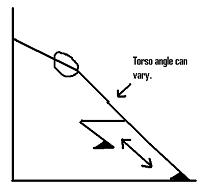|
A: Yes, practice the movement at least 2 days per week and make sure you get full hip extension upon the take off. The broad jump inherently involves more glute and hamstring activation vs quadricep in comparison to a regular vertical jump due to the angle of the torso.
Q: What do you think about using weighted vests and sleds for developing speed? A: Good question! I think the weighted vests are useful but they are better for developing vertical jumping ability then they are acceleration ability. This is because with the weighted vest the load is completely vertical whereas the load when pulling a sled is horizontal. A weighted vest used with about 10% of your bodyweight can be used in 2 ways. 1. Simply wear it around all the time except for bed for 3 weeks and do what you normally do in regards to training. A study using weighted vests showed an increase in the vertical jump of 4-5 inches simply by wearing one around consistently for 3 weeks (Bosco). 2. If you don't want to wear the thing around all the time use it for workouts only and perform low and moderate intensity plyometrics like ankle jumps, tuck jumps, and low depth jumps. You can do a higher volume of the low intensity drills like ankle jumps but no more than 40 repetitions total of the more intense varieties. I would imagine if your only goal is speed the weight vest would still be effective if you wear it around all the time for 3 weeks while removing it for your sprinting sessions, but this is only conjencture at this time. Now sleds can definitely be used as a valuable part of sprint acceleration training. Here are some guidelines regarding their usage some of which are the recommendations of Charlie Francis who is probably the greatest speed coach ever: 1. Use a sled for acceleration runs only. Don't use it for distances over 30 meters and I would recommend you not use it more than 6 weeks at a time restricting use to 2 sessions per week at the most. 2. Use a resistance that causes your acceleration times to decline by no more than 10% - anymore than this and your mechanics will faulter too much. 3. Couple sprints using the sled resistance with normal unweighted sprints. So you might perform 3 acceleration runs with the sled followed by 2 without the sled. When it comes to choosing a sled you can either buy your own or make one. If you choose to purchase one you can find a high quality sled at www.elitefts.com. If you want to get creative and make your own practically anything will suffice. You can use tires, weight plates, or even regular snow sleds weighted with dumbells. -Kelly Q: I've been told I really need to work my hamstrings for optimal sprint speed and technique. What exercises should I be doing? There are more than enough quality hamstring and posterior chain exercises to choose from but before you go killing yourself in the gym answer 2 other questions that are rarely asked when considering devoting a large amount of time to sport specific hamstring training: 1. Are you engaging your hamstrings optimally whenever you sprint? 2. Are you able to transfer added weight room hamstring "strength" into added performance in your sprints? You see, a lot of people over muscle their stride motion and aren't able to relax. They thus cut off their stride early and don't fully extend their hips and because of this they aren't able to engage the hamstrings optimally. This makes any hamstring strength gained in the gym relatively useless. People often "try" too hard to accelerate and run fast and all this does is slow them down. Now for the 2nd part - strength is more a function of voluntary muscular contraction than reflexive/reactive contraction. Speed is primarily a reflexive development function that is supported by voluntary muscular force capabilities. This means you do need the right amount of "weight room" strength but too much can often be as bad as too little because performing too much strength work can inhibit your reflexive firing. Pay attention to the function of your hamstrings first by analyzing video of your sprints and check for full extension. Once you have this in place you can then work on boosting the output of that function in the weight room. And finally to answer your question on exercises - Do plenty of hip extension type hamstring exercises. These include deadlifts, good mornings, stiff-legged deadlifts, glute-ham raises, and reverse hypers and basically anything that engages the hamstrings via extension of the hips. I'm also going to give you a simple functional hamstring exercise you probably haven't seen before. Lean against a wall with your hands supporting you. Your feet should be back away from the wall with your ankles, knees, hips, shoulders and head all in relative alignment. Next, bring one knee up while fully extending the support leg. Now bring the other leg up. Now run in place for 10 seconds concentrating on getting a full and complete extension with each stride. Your hamstrings should be contracting with each ground contact. This is the type of lean and extension you should have while accelerating but keep in mind you can't "think" about this while sprinting or you'll shoot yourself in the foot. You have to practice it during drills and allow it to naturally carry over into your sprints. Look at the figure below to see an illustration of the wall drill.

|